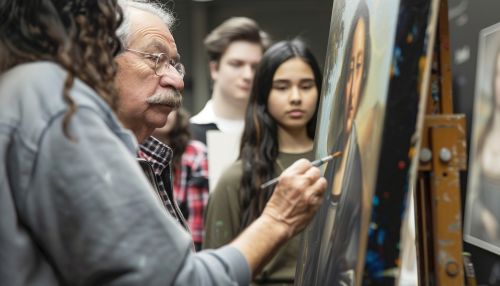History of art education
Early History of Art Education
Art education has a rich and varied history that spans across different cultures and epochs. The earliest forms of art education can be traced back to prehistoric times when humans first began to create cave paintings and carvings. These early artistic endeavors were not only a means of expression but also served as a way to communicate and document experiences.
In ancient civilizations such as Egypt, Greece, and Rome, art was an integral part of daily life and was often used for religious and ceremonial purposes. The ancient Egyptians developed a highly formalized and symbolic art style, which was taught to apprentices by master artists. Similarly, in ancient Greece, art education was part of a broader educational curriculum that included music, poetry, and physical education. Greek artists were trained in workshops where they learned techniques and styles from established masters.
Medieval and Renaissance Periods
During the medieval period, art education was primarily conducted within the confines of monasteries and religious institutions. Monks and nuns were often the primary creators of illuminated manuscripts, which required a high level of skill in both art and calligraphy. The Gothic period saw the rise of cathedral schools where art and architecture were taught as part of the broader curriculum.
The Renaissance period marked a significant turning point in the history of art education. The revival of classical learning and the emphasis on humanism led to the establishment of formal art academies. The Accademia di Belle Arti in Florence, founded in 1563, is one of the earliest examples of such institutions. These academies provided structured training in drawing, painting, sculpture, and architecture, and emphasized the study of anatomy, perspective, and classical art forms.


18th and 19th Centuries
The 18th and 19th centuries witnessed the expansion of art education beyond the confines of elite academies. The Enlightenment period emphasized reason, science, and the arts, leading to the establishment of public art schools and museums. The Royal Academy in London, founded in 1768, played a crucial role in promoting art education and establishing standards for artistic training.
In the United States, art education began to take root in the 19th century with the founding of institutions such as the Pennsylvania Academy of the Fine Arts in 1805. These institutions aimed to provide comprehensive training in the visual arts and to cultivate an appreciation for art among the general public. The Arts and Crafts movement, which emerged in the late 19th century, further emphasized the importance of craftsmanship and the integration of art into everyday life.
20th Century Developments
The 20th century brought significant changes to art education, influenced by various artistic movements and educational philosophies. The Bauhaus school, founded in 1919 in Germany, revolutionized art education by integrating fine arts, crafts, and industrial design. The Bauhaus emphasized the importance of functionalism, simplicity, and the unity of art and technology.
In the mid-20th century, the Abstract Expressionist movement and other avant-garde art movements challenged traditional notions of art and art education. Art schools began to adopt more experimental and interdisciplinary approaches, encouraging students to explore new media and techniques.
The latter half of the 20th century also saw the rise of art education in public schools, with programs designed to foster creativity and critical thinking among students. Organizations such as the National Art Education Association in the United States played a pivotal role in advocating for the inclusion of art in the general education curriculum.
Contemporary Art Education
Today, art education continues to evolve, influenced by technological advancements and global cultural exchanges. Digital media and online platforms have expanded the possibilities for art education, allowing students to access a wealth of resources and connect with artists and educators worldwide.
Contemporary art education programs often emphasize interdisciplinary approaches, integrating art with subjects such as science, technology, engineering, and mathematics (STEM). This approach, known as STEAM education, aims to foster innovation and creativity by highlighting the connections between art and other fields.
Art education also plays a crucial role in promoting cultural diversity and social justice. Programs that focus on community art and art therapy seek to empower individuals and communities through creative expression and to address social and emotional issues.
